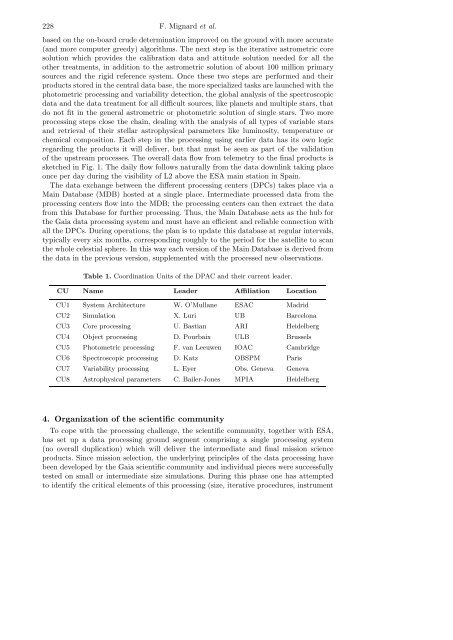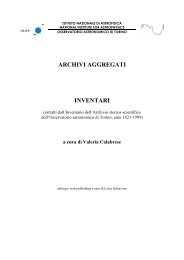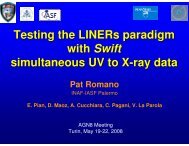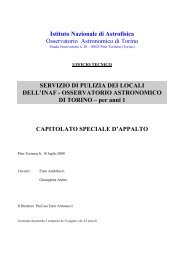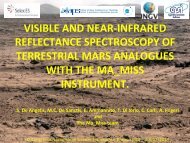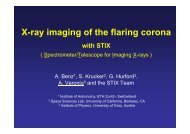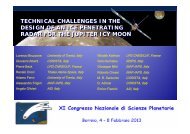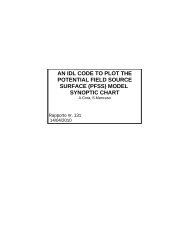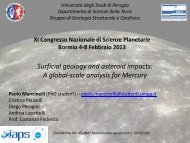Gaia - Osservatorio Astronomico di Torino
Gaia - Osservatorio Astronomico di Torino
Gaia - Osservatorio Astronomico di Torino
You also want an ePaper? Increase the reach of your titles
YUMPU automatically turns print PDFs into web optimized ePapers that Google loves.
228 F. Mignard et al.<br />
based on the on-board crude determination improved on the ground with more accurate<br />
(and more computer greedy) algorithms. The next step is the iterative astrometric core<br />
solution which provides the calibration data and attitude solution needed for all the<br />
other treatments, in ad<strong>di</strong>tion to the astrometric solution of about 100 million primary<br />
sources and the rigid reference system. Once these two steps are performed and their<br />
products stored in the central data base, the more specialized tasks are launched with the<br />
photometric processing and variability detection, the global analysis of the spectroscopic<br />
data and the data treatment for all <strong>di</strong>fficult sources, like planets and multiple stars, that<br />
do not fit in the general astrometric or photometric solution of single stars. Two more<br />
processing steps close the chain, dealing with the analysis of all types of variable stars<br />
and retrieval of their stellar astrophysical parameters like luminosity, temperature or<br />
chemical composition. Each step in the processing using earlier data has its own logic<br />
regar<strong>di</strong>ng the products it will deliver, but that must be seen as part of the validation<br />
of the upstream processes. The overall data flow from telemetry to the final products is<br />
sketched in Fig. 1. The daily flow follows naturally from the data downlink taking place<br />
once per day during the visibility of L2 above the ESA main station in Spain.<br />
The data exchange between the <strong>di</strong>fferent processing centers (DPCs) takes place via a<br />
Main Database (MDB) hosted at a single place. Interme<strong>di</strong>ate processed data from the<br />
processing centers flow into the MDB; the processing centers can then extract the data<br />
from this Database for further processing. Thus, the Main Database acts as the hub for<br />
the <strong>Gaia</strong> data processing system and must have an efficient and reliable connection with<br />
all the DPCs. During operations, the plan is to update this database at regular intervals,<br />
typically every six months, correspon<strong>di</strong>ng roughly to the period for the satellite to scan<br />
the whole celestial sphere. In this way each version of the Main Database is derived from<br />
the data in the previous version, supplemented with the processed new observations.<br />
Table 1. Coor<strong>di</strong>nation Units of the DPAC and their current leader.<br />
CU Name Leader Affiliation Location<br />
CU1 System Architecture W. O’Mullane ESAC Madrid<br />
CU2 Simulation X. Luri UB Barcelona<br />
CU3 Core processing U. Bastian ARI Heidelberg<br />
CU4 Object processing D. Pourbaix ULB Brussels<br />
CU5 Photometric processing F. van Leeuwen IOAC Cambridge<br />
CU6 Spectroscopic processing D. Katz OBSPM Paris<br />
CU7 Variability processing L. Eyer Obs. Geneva Geneva<br />
CU8 Astrophysical parameters C. Bailer-Jones MPIA Heidelberg<br />
4. Organization of the scientific community<br />
To cope with the processing challenge, the scientific community, together with ESA,<br />
has set up a data processing ground segment comprising a single processing system<br />
(no overall duplication) which will deliver the interme<strong>di</strong>ate and final mission science<br />
products. Since mission selection, the underlying principles of the data processing have<br />
been developed by the <strong>Gaia</strong> scientific community and in<strong>di</strong>vidual pieces were successfully<br />
tested on small or interme<strong>di</strong>ate size simulations. During this phase one has attempted<br />
to identify the critical elements of this processing (size, iterative procedures, instrument


